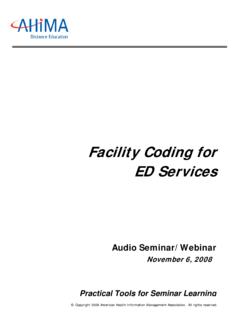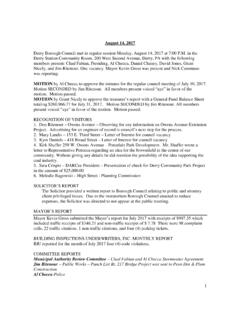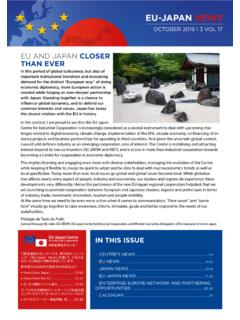Transcription of Understanding Convolutional Neural Networks
1 Fakult t f r Mathematik, Informatik und Naturwissenschaften Lehr- und Forschungsgebiet Informatik VIII. Computer Vision Prof. Dr. Bastian Leibe Seminar Report Understanding Convolutional Neural Networks David Stutz Matriculation Number: ######. August 30, 2014. Advisor: Lucas Beyer Abstract This seminar paper focusses on Convolutional Neural Networks and a visualization technique allowing further insights into their internal operation. After giving a brief introduction to Neural Networks and the multilayer perceptron, we review both supervised and unsupervised training of Neural Networks in detail.
2 In addition, we discuss several approaches to regularization. The second section introduces the different types of layers present in recent Convolutional Neural net- works. Based on these basic building blocks, we discuss the architecture of the traditional Convolutional Neural network as proposed by LeCun et al. [LBD+ 89] as well as the architecture of recent implementa- tions. The third section focusses on a technique to visualize feature activations of higher layers by backpro- jecting them to the image plane. This allows to get deeper insights into the internal working of convolu- tional Neural Networks such that recent architectures can be evaluated and improved even further.
3 2. Contents 1 Motivation 4. Bibliographical Notes .. 4. 2 Neural Networks and Deep Learning 5. Multilayer Perceptrons .. 5. Activation Functions .. 6. Supervised Training .. 7. Error Measures .. 8. Training Protocols .. 8. Parameter Optimization .. 8. Weight Initialization .. 9. Error Backpropagation .. 10. Unsupervised Training .. 10. Auto-Encoders .. 10. Layer-Wise Training .. 11. Regularization .. 11. L p -Regularization .. 11. Early Stopping .. 12. Dropout .. 12. Weight Sharing .. 12. Unsupervised Pre-Training .. 12. 3 Convolutional Neural Networks 13.
4 Convolution .. 13. Layers .. 13. Convolutional Layer .. 13. Non-Linearity Layer .. 14. Rectification .. 15. Local Contrast Normalization Layer .. 15. Feature Pooling and Subsampling Layer .. 15. Fully Connected Layer .. 16. Architectures .. 16. Traditional Convolutional Neural Network .. 16. Modern Convolutional Neural Networks .. 17. 4 Understanding Convolutional Neural Networks 18. Deconvolutional Neural Networks .. 18. Deconvolutional Layer .. 18. Unsupervised Training .. 19. Visualizing Convolutional Neural Networks .. 19. Pooling Layers .. 19.
5 Rectification Layers .. 20. Convolutional Neural Network Visualization .. 20. Filters and Features .. 20. Architecture Evaluation .. 20. 5 Conclusion 21. 3. 1 Motivation Artificial Neural Networks are motivated by the learning capabilities of the human brain which consists of neurons interconnected by synapses. In fact at least theoretically they are able to learn any given mapping up to arbitrary accuracy [HSW89]. In addition, they allow to easily incorporate prior knowledge about the task into the network architecture. As result, in 1989, LeCun et al.
6 Introduced Convolutional Neural Networks for application in computer vision [LBD+ 89]. Convolutional Neural Networks use images directly as input. Instead of handcrafted features, Convolutional Neural Networks are used to automatically learn a hierarchy of features which can then be used for classi- fication purposes. This is accomplished by successively convolving the input image with learned filters to build up a hierarchy of feature maps. The hierarchical approach allows to learn more complex, as well as translation and distortion invariant, features in higher layers.
7 In contrast to traditional multilayer perceptrons, where deep learning is considered difficult [Ben09], deep Convolutional Neural Networks can be trained more easily using traditional methods1 . This property is due to the constrained architecture2 of Convolutional Neural Networks which is specific to input for which discrete convolution is defined, such as images. Nevertheless, deep learning of Convolutional Neural Networks is an active area of research, as well. As with multilayer perceptrons, Convolutional Neural Networks still have some disadvantages when com- pared to other popular machine learning techniques as for example Support Vector Machines as their internal operation is not well understood [ZF13].
8 Using deconvolutional Neural Networks proposed in [ZKTF10], this problem is addressed in [ZF13]. The approach described in [ZF13] allows the visualization of feature activations in higher layers of the network and can be used to give further insights into the internal operation of Convolutional Neural Networks . Bibliographical Notes Although this paper briefly introduces the basic notions of Neural Networks as well as network training, this topic is far too extensive to be covered in detail. For a detailed discussion of Neural Networks and their training several textbooks are available [Bis95, Bis06, Hay05].
9 The Convolutional Neural network was originally proposed in [LBD+ 89] for the task of ZIP code recog- nition. Both Convolutional Neural Networks as well as traditional multilayer perceptrons were excessively applied to character recognition and handwritten digit recognition [LBBH98]. Training was initially based on error backpropagation [RHW86] and gradient descent. The original Convolutional Neural network is based on weight sharing which was proposed in [RHW86]. An extension of weight sharing called soft weight sharing is discussed in [NH92]. Recent implementations make use of other regularization techniques as for example dropout [HSK+ 12].
10 Although the work by Hinton et al. in 2006 [HO06] can be considered as breakthrough in deep learning . as it allows unsupervised training of Neural Networks deep learning is still considered difficult [Ben09]. A thorough discussion of deep learning including recent research is given in [Ben09] as well as [LBLL09, GB10, BL07]. Additional research on this topic includes discussion on activation functions as well as the effect of unsupervised pre-training [EMB+ 09, EBC+ 10, GBB11]. Recent architectural changes of Convolutional Neural Networks are discussed in detail in [JKRL09] and [LKF10].




